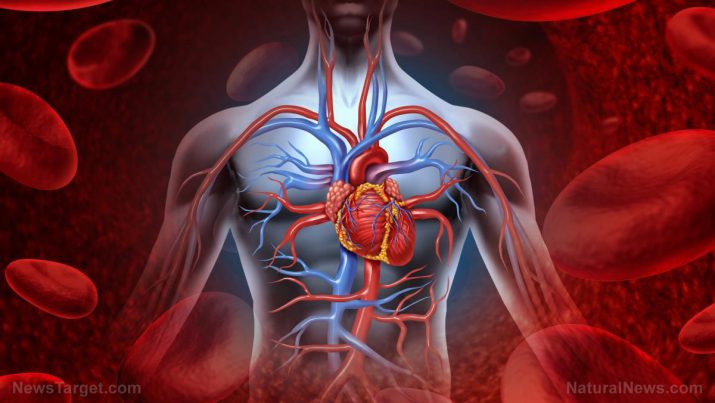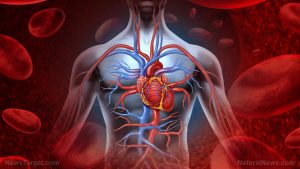
Diastolic dysfunction – causes, side effects and treatments at NaturalPedia.com
Saturday, March 10, 2018 by Ralph Flores
http://www.naturalpedia.com/diastolic-dysfunction-causes-side-effects-and-treatments-at-naturalpedia-com.html

A diastolic dysfunction, also known as a diastolic failure, is a condition wherein the left ventricle of the heart becomes stiff and loses its ability to relax normally. When this happens, the heart is unable to fill itself with blood during the resting period between each beat.
The diastole is defined as the process wherein the heart returns to its “relaxed state,” that is, the time when the chambers are filled with blood before it is pumped into circulation in the systole period. During this time, noticeable changes in the cardiac pressure and the volume occur. When a person suffers from diastolic dysfunction, the heart needs higher diastolic pressures to meet the body’s metabolic needs. This leads to a decreased compliance which can cause pulmonary congestion (the buildup of fluid in the lungs), dyspnea (labored breathing), and heart failure.
One of the most common causes of diastolic dysfunction is prolonged periods of hypertension, which causes an abnormal increase in pressure exerted by the left ventricle. Another factor for the condition is age: Diastolic dysfunction is commonly seen in older adults – given their loss of elastic fibers and increased collagen cross-linking.

Known risk factors and symptoms of diastolic dysfunction
Some factors contribute to having diastolic dysfunction. These include the following:
- Aortic stenosis — This condition is characterized by a narrowed opening in the aortic valve, which can lead to a thickening of the left ventricle.
- Hypertrophic cardiomyopathy — It occurs if the heart muscle cells enlarge, thickening the wall of the left ventricle. This could block blood flow from the ventricle in a condition called obstructive hypertrophic cardiomyopathy.
- Pericardial disease — The condition, an inflammation of the membrane enclosing the heart, can lead to fluid buildup in the pericardial space.
Moreover, a person who has previously experienced a heart attack (or myocardial infarction) and those with diabetes are also at risk of getting diastolic dysfunction.
Symptoms include the following:
- Awakening at night with shortness of breath
- Breathlessness or shortness of breath during exercise or when lying flat
- Coughing or wheezing, sometimes with white or pink phlegm
- Difficulty concentrating
- Fatigue
- Fluid retention causing swelling in the ankles, legs, feet, and abdomen
- Lack of appetite and nausea
- Rapid or irregular heartbeat
- Sudden weight gain
Body systems affected by diastolic dysfunction
The condition primarily affects the left ventricle of the heart; however, its effects can lead to chronic heart failure.
Food items or nutrients that may prevent or relieve diastolic dysfunction
Research has shown that exercise is highly beneficial for people with diastolic dysfunction. In a study, researchers demonstrated that people who regularly exercise improved their diastolic function.
In addition, a separate study conducted by the Technical University of Munich suggested a low-glycemic diet made up of 25 percent carbohydrates, 45 percent fat, and 30 percent protein. Clinical tests showed that the diet improved the diastolic function of participants.
Treatment and management options for diastolic dysfunction
Diastolic dysfunction may be asymptomatic in its early stages and symptoms may only manifest itself once it has advanced; therefore, early detection and treatment are vital factors before it severely impairs heart function. If a person has already been diagnosed with diastolic dysfunction, healthcare professionals will present several treatment options.
- Diuretics are used to reduce pulmonary congestion, a common complication of the condition, and prevents the likelihood of stroke.
- Beta-blockers control blood pressure, which may reduce myocardial hypertrophy.
- Calcium channel blockers are known to assist in diastolic filling and reduce muscle mass in patients with hypertension.
When medications are ineffective, surgery could be suggested to repair a blocked artery or heart valve.
Where to learn more
- Cancer drugs cause serious heart damage in nearly 75 percent of long-term patients
- Culinary Rx: Beet Juice vs Drugs for High Blood Pressure
- Who needs meds? Simple potassium may lower blood pressure more safely than prescription drugs
- Yogurt and probiotic-rich foods can help lower blood pressure
- Know the truth about blood pressure
Summary
Diastolic dysfunction is a condition wherein the left ventricle of the heart becomes stiff and loses its ability to relax normally. When a person suffers from diastolic dysfunction, the heart needs higher diastolic pressures to meet the body’s metabolic needs. This leads to a decreased compliance which can cause pulmonary congestion (the buildup of fluid in the lungs), dyspnea (labored breathing), and heart failure.
One of the most common causes of diastolic dysfunction is prolonged periods of hypertension. Another factor for the condition is age. Moreover, a person who has previously experienced a heart attack (or myocardial infarction) and those with diabetes are also at risk of getting diastolic dysfunction.
Exercise is highly beneficial for people with diastolic dysfunction.
Sources include:
Tagged Under: Tags: diastolic dysfunction





